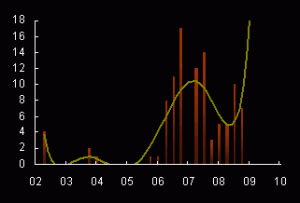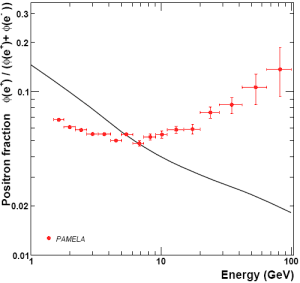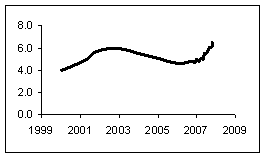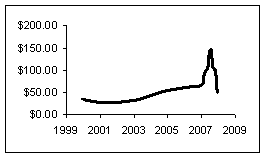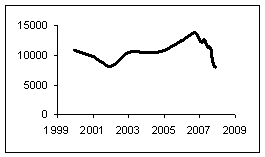I’ve been reading a lot about gauge theories lately. I once wrote what I thought was a fine and concise description of the principle of gauge invariance, but I needed Schrödinger’s equation for it, which made my explanation both non-classical and non-relativistic.
Finally, with the help of a Wikipedia article no less, I think I managed to understand how a gauge theory can come into being without involving any quantum physics. It’s simple, really, surprisingly so.
What you need is a (classical) field theory. A field theory is specified by its Lagrangian, which, crudely speaking, is just the difference between the kinetic and potential energy. For a scalar field φ, the kinetic energy of the field is the square of its gradient, ∂μφ∂μφ. The potential term can be nothing (massless particle in empty space) or it can contain a mass term in the form m2φ2.
Where things begin to get interesting is when we allow φ to be a complex field. In this case, rather than writing φ2, we must now write φφ*, where φ* is the complex conjugate of φ. The same thing happens in the kinetic term. So now the Lagrangian reads,
L = ∂μφ∂μφ* – m2φφ*.
The reason why this is so interesting is that if we change the phase of φ by a set amount (i.e., multiply φ by eiψ) the conjugate’s phase changes by the opposite amount (i.e., φ* it gets multiplied by e–iψ). Their product, therefore, multiplied by eiψe–iψ = 1, remains unchanged. In other words, our Lagrangian is invariant under a global rotation in the complex plane. Right there, this has an important implication: as per Noether’s theorem, a global symmetry implies the existence of a conserved current.
But what if the symmetry is not global but local? Meaning that we rotate φ in the complex plane as before, but the angle of rotation is not the same everywhere? Clearly, φφ* still remains unchaged just as before, but the same is not true for ∂μφ∂μφ*; the derivative operator brings new terms into the Lagrangian.
These new terms are best dealt with by changing the derivative operator into a covariant derivative: ∂μ → Dμ = ∂μ + Aμ, where Aμ is an arbitrary vector field.
Or maybe not so arbitrary. We can make Aμ anything we want, of course, but that also means that we can demand that Aμ satisfy a field equation. Perhaps the field equations of electromagnetism… why not? (After all, every vector field satisfies the field equations of electromagnetism.)
The difference between the original Lagrangian (written using the ordinary derivative ∂μ) and the new Lagrangian (written using the covariant derivative operator Dμ) is the interaction Lagrangian that describes how the φ field interacts with itself through a vector field Aμ. By making the complex φ field locally gauge invariant, we have, in effect, invented the electromagnetic vector potential Aμ.
This is, after all, what gauge theories do: they turn a local symmetry into a force. The local symmetry can be geometric in nature (e.g., a rotation) or it can be an internal symmetry of a field that is not described by simple real numbers. In the present example, the field was made up of complex numbers, and the symmetry was that of the complex plane. This symmetry group is U(1), which is an Abelian group: two rotations in the complex plane, executed one after the other, produce the same result regardless of the order in which they are executed.
In many physically important cases, the symmetry is non-Abelian. The most profound consequence of this is that in place of the gauge field Aμ, which is “inert”, we get gauge field(s) that interact with themselves. In practical terms, when the theory is Abelian, like electromagnetism, the gauge field Aμ represents photons, which are uncharged; but when the theory is non-Abelian, like electroweak theory, the gauge fields are non-Abelian, carry charge, and interact with each other.
